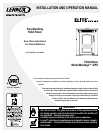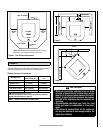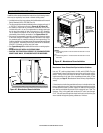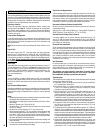
4
WARNING
Electrical grounding instructions: This appliance is
equipped with a three-prong (grounding) plug for
your protection against shock hazard and should be
plugged directly into a properly grounded three-prong
receptacle. Do not cut or remove the grounding prong
from this plug. Do not route power cord under or in
front of appliance.
2. Local amendments
3. Is a permit required - cost. You may wish to contact your insurance
company to ask if they require this.
4. If outside combustion air is required
5. Rooms where the installation is not allowed
Surge Protectors
A surge protector is recommended to ensure the stove’s electrical com-
ponents are not damaged due to a surge in the electrical supply. Only
high quality protectors should be used - cheap ones do not provide the
protection needed.
Smoke Detectors
Since there are always several potential sources of fire in any home, we
recommend installing smoke detectors. If possible, install the smoke
detector in a hallway adjacent to the room (to reduce the possibility of
occasional false activation from the heat produced by these appliances).
If your local code requires a smoke detector be installed within the same
room, you must follow the requirements of your local code. Check with
your local building department for requirements in your area.
Installation / Maintenance Standards
National Fire Protection Association – The primary NFPA standard that
refers to installation and maintenance of pellet stoves and venting is
NFPA 211 – Latest Edition: Chimneys, Fireplaces, Vents, and Solid Fuel
appliances.
This appliance requires noncombustible floor protection (the hearth pad
or alternate floor protection material does not require a thermal rating).
A noncombustible floor protector must fully cover the area beneath the
appliance and extend 6” to the front, 6” to the sides, and up to 6” from
the back as illustrated in Figure 1.
If the floor protection is to be stone, tile, brick, etc., it must be mortared
or grouted to form a continuous noncombustible surface. If a chimney
connector extends horizontally over the floor, protection must also cover
the floor under the connector and at least 2” (51 mm) to either side. See
Clearances and Hearth Protection shown in Figure 1.
CAUTION
These appliances are very heavy. The use of a heavy
duty escalara (stair step hand truck) is recommended
for lifting the appliance.
The design of your home and where you place your stove will determine
its value as a source of heat. This type of appliance depends primarily on
air circulation (convection) to disperse its heat, and therefore, a central
location is often best. There are other practical considerations, which must
be considered before a final selection of locations is made.
• Existing Chimneys
• Pellet Fuel Storage
• Aesthetic Considerations
• Roof Design (rafter locations and roof pitch)
• Room Traffic
• Proximity to Combustibles
• Electrical Wiring
SELECTING A LOCATION
FLOOR PROTECTION
Power Supply Requirements
These requirements must be met unless otherwise specified by state or
local authorities.
•
Power Cord - The power cord must be plugged into a standard, 120
Volt, 60 Hz grounded electrical outlet with proper ground and polarity.
The power cord must be routed to avoid contact with any of the hot
or sharp exterior surface areas of the stove.
•
Power Supply - 575 Watts, and will peak up to 782 Watts during the
30 minute cycle when igniter is operating.
•
Manufactured Home Installations - When installed into a manufactured
home, the appliance must be electrically grounded to the steel chassis
(see Page 7, Manufactured Home Requirements).
NEGATIVE PRESSURE WARNING
This appliance is not designed to be operated in a negative pressure. Very
airtight homes with large kitchen exhaust fans, or homes with furnace
cold air returns located in close proximity to the stove may create nega-
tive pressure in the same room as the heating appliance. This can create
dangerous condition, drawing combustion by-products into the home. Be
sure your home has adequate makeup air to eliminate negative pressures
caused by the above-mentioned sources. Outside air connected to the
appliance probably will not resolve such a problem as the stove is not the
source of negative pressure. Lennox Hearth Products accepts no liability
for damages resulting from negative pressures described here.
Ventilation Requirements - Provide adequate air for combustion. The fresh
air requirements of this appliance must be met within the space where it
will be installed. Ventilation is essential when using a solid-fuel-burning
heater. In well insulated and weather tight homes, it may inhibit the rate
the exhaust flows through the venting system (caused by a shortage of
air in the home). The lack of air is caused by many common household
appliances which exhaust air from the home (such as a furnace, heat
pump, air conditioner, clothes dryer, exhaust fans, fireplaces, and other
fuel burning appliances). Also, the combustion process of this heater
uses oxygen from inside the dwelling. If the available fresh air delivery
in the dwelling is insufficient to support the demands of these appli-
ances, problems can result (i.e. excessive negative pressure will result
in performance problems. To correct this problem it may help to open
a window (preferably on the windward side of the house) or install an
outside combustion air duct to the appliance.


















